Practice Questions for The Exam
1/66
There's no tags or description
Looks like no tags are added yet.
Name | Mastery | Learn | Test | Matching | Spaced |
|---|
No study sessions yet.
67 Terms
The following conditions is NOT a condition of the eyelid
A. MGD
B. Ingrowing toenails
C. Ectropion
D. Ptosis
E. Trichiasis
A. MGD - blocked meibomian glands
B. Ingrowing toenails
C. Ectropion - eyelid turned outward
D. Ptosis - droopy eyelid
E. Trichiasis - eyelashes growing inward
Final answer = B. Ingrown Toenail
What is Sodium fluorescein dye used for?
A. Painting walls
B. Colouring orange juice
C. Corneal staining
D. Assessing soft contact lens fitting
E. Numbing the cornea
B. Corneal Staining
What is the most suitable management for MGD?
A. Eye exercises
B. Refer to Ophthalmologist
C. Refer to General Practitioner urgently
D. Eyelid scrubs and hot compress
E. Steroidal eye drops
D. Eyelid Scrubs and Hot Compress
Arri is a stay at home dad with a 4 month old son.
He likes kick boxing which he does once a week but is worried about breaking his glasses. Rx -6.75DS R&L. Which lens type is most suitable for Arri?
A. Soft daily disposable
B. Soft monthly toric
C. RGP back surface toric
D. Soft daily multifocal
E. Soft monthly multifocal
A. Soft Daily Disposable
Which of the following is the CORRECT statement regarding Soft contact lenses?
A. They are most comfortable on Saturdays
B. They should be fitted steep
C. They can be fitted off centre if the patient needs to fit lightbulbs
D. Should not cause blanching of the limbal vessels
E. Should sit 2mm inside the limbus all the way around
D. Should not cause blanching of the limbal vessels
Using the 3,6,9 rule, a Px with a spectacle Rx of -8.25 would need a CL of:
A. -6.50
B. -6.00
C. -7.75
D. -8.25
E. -9.00
C. -7.75
A 36-year-old female, non-contact lens wearer, attends for an eye exam complaining of dryness and irritation in both eyes. Look at the photo below. What is your diagnosis?
A. Her contact lens is inside out
B. Acanthamoeba keratitis
C. Bacterial conjunctivitis
D. Presbyopia
E. Trichiasis
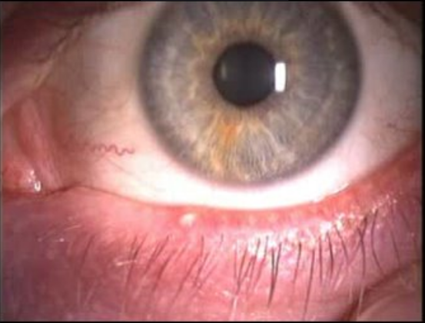
C. Bacterial conjunctivitis or E. Trichiasis. Still not 100% sure
A contact lens has the following specification: 8.5 14.20 +3.50 What does the number “8.5” refer to?
A. Back vertex power
B. Back optic zone radius
C. Back optic zone diameter
D. Total diameter
E. Centre Thickness
8.5 = Base Curve (Back Optic Zone Radius)
14.20 = Total Diamter
+3.50 = Back Vertex Power
Final answer - B. Back Optic Zone Radius
A contact lens wearer complains that their vision is hazy towards the end of the day. Your Aftercare indicates that the lens has no movement. What is the most suitable management?
A. Tell the patient to blink more
B. Increase the base curve of the contact lens
C. Increase the oxygen permeability of the contact lens
D. Reduce the wearing time
E. Increase the diameter of the contact lens
B. Increase the base curve of the contact lens
Which statement is CORRECT regarding newly fitted contact lens patients?
A. Patients who are unable to remove their lenses during their initial instruction should not be issued with lenses
B. Patients unable to remove lenses easily during their initial instruction should be told to practise at home and call the optometrist if they get stuck
C. Patients struggling to remove lenses in practice should be encouraged to ask a friend who wears lenses to help remove them
D. Patients should be told to return to the Emergency department if they
E. Patients should be told to look on line at video instructions if they are struggling to remove their lenses during their initial instruction
B. Patients unable to remove lenses easily during their initial instruction should be told to practice at home and call the optometrist if they get stuck
Conjunctivitis is MOST likely to present with:
A. Tonsilitis
B. Cataracts
C. Poor VA
D. Cicatrization
E. Hyperaemia
E. Hyperaemia
You would be LEAST likely to use direct illumination to assess:
A. Corneal Oedema
B. Scleral pathology
C. Meibomian Gland Dysfunction
D. Palpebral papillae
E. Corneal thickness
A. Corneal Oedema
Which of the following instruments is used to measure the radius of corneal curvature.
A. Lens Radiuscope
B. Slit Lamp
C. Burton Lamp
D. Topographer
E. Retinoscope
D. Topographer
Which of the following is least likely to be used for assessment of soft contact lenses?
A. Lissamine Green
B. Fluorescein sodium
C. Slit lamp with white light
D. Rose Bengal
E. Schirmer Test
Lissamine Green - It stains dead and degenerated cells, mucus, and areas of epithelial damage, helping clinicians assess conditions like dry eye and identify issues with contact lenses or surgery. LG is a vital stain, meaning it stains cells and tissues in their living state.
Fluorescein Sodium - The dye stains damaged areas, allowing for easier detection of corneal abrasions, ulcers, foreign bodies, and other issues under a blue light
Rose Bengal - It has several applications, including identifying damaged cells, staining mucus, and detecting certain diseases.
Schirmer Test - a diagnostic tool used to measure tear production, primarily to assess the cause of dry eye.
Final Answer: E. Schirmer Test
For the image below which is the MOST likely diagnosis?
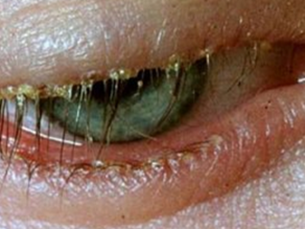
A. Blepharitis
B. Scleritis
C. Palpebralitis
D. Acanthamoeba keratitis
E. Keratoconus
A. Blerpharitis
Which is CORRECT - if you found Keratometry measurements for the Right eye of:
RE 9.05 @ 90 7.65 @ 180
A. Spherical cornea
B. Moderate corneal astigmatism
C. Minimal corneal astigmatism LE (<0.50DC)
D. Irregular astigmatism
E. WTR astigmatism
B. Moderate Corneal Astigmatism
Which of the following is a requirement for a contact lens solution?
A. Non toxic
B. Toxic preservatives
C. Complicated to use
D. All-in- One
E. Contaminated
A. Non Toxic
Describe the contact lens in the image below (4 marks):
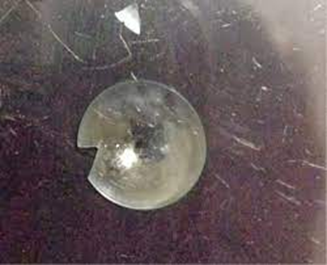
The contact lens is torn roughly in the 9 o clock area, the lens seems slightly cloudy, the lens seems to have scratches and has small deposits.
If your patient was wearing this lens to their appointment, list FOUR ways this would this affect your management? (4 Marks)
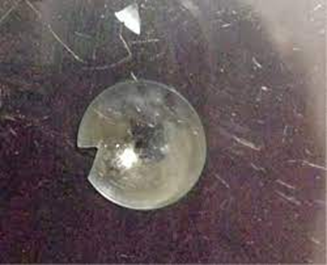
I could not do a proper aftercare or check because the lens is torn
I would need to source another lens and if not ask the patient to reschedule
I would have to enquiry the patients compliance with contact lens rules
I would have to investigate why the patient would wear a torn lens.
I would then have to reteach the patient of the proper contact lens care
I would have to spend time assessing the health of the patient’s eye and if there was any corneal damage / staining
Your patient has not been to see you before, but reports they had problems with their previous contact lenses. What could you ask to find out if this is likely to be a problem.
List SIX questions along with the reason each might identify the cause of the problem or how it would affect your management. (Marks 12)
Which lenses were they wearing previously? - know brand
Do they know the prescription of what their previous lenses are? - important in case this incorrect
How often were they wearing their lenses? - need to know modality
What exact problem were they having with the lenses i.e comfort or vision related? - need to know chief complaint
What were they using the contact lenses for when they would wear them? - sports, everyday wear, going out
Do they have any ocular or health conditions that I should be aware of? - dry eye, diabetes and inflammatory diseases can make wearing lenses difficult
List THREE benefits of a silicon-hydrogel material over a standard hydrogel contact lens. (3 marks)
Silicon Hydrogel Benefits
Better oxygen permeability
Better comfort as lens not as thick
Higher modulus so stiffer and possibly easier to handle for some patients
List 10 Contraindications for Contact Lens Wear (10 Marks)
Dry eyes
Contact Lens-induced Peripheral Ulcer (CLPU)
Contact Lens-induced Acute Red Eye (CLARE)
Microbial Keratitis
Microcysts
Vacuoles
Acanthamoeba
Giant papillary conjunctivitis (GPC)
Conjunctivitis
Superior Epithelial Arcuate Leison (SEAL)
Read the approximate reading (2 marks)
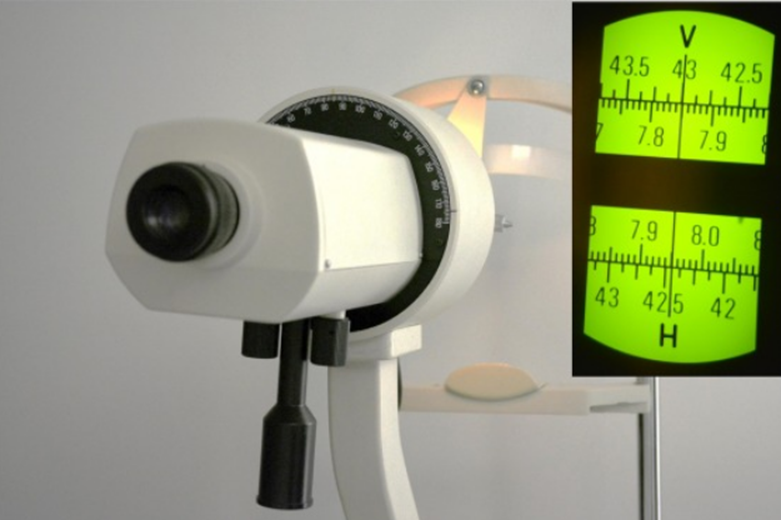
7.85 @ 90 7.95 @180
What is the reason for good hygiene with contact lens wear? List FOUR examples. (4 Marks)
Good hygiene is important because it reduces the risk of infection
Good hygiene is important because biofilms can build up on lenses
Good hygiene is important because it can cause vision loss if not adhered too
Good hygiene is important because it can lead to patient being barred from contact lens wear
Describe the slit lamp corneal appearance of the left eye in the image below: (4 marks)
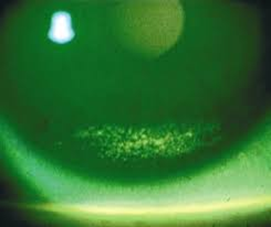
The staining in this image is a SMILE stain, which means it is inferior epithelial arcuate leison and it is localised between 4 and 8 o clock.
List THREE ways you could manage this patient. (3 marks)
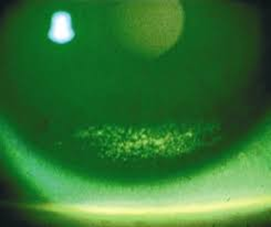
Stop contact lens wear for some time to let the lesion heal
Go over hygiene protocols with my patient
Reduce the patient’s overall wear time
Using bullet points, describe TWO other types of corneal staining (6 marks)
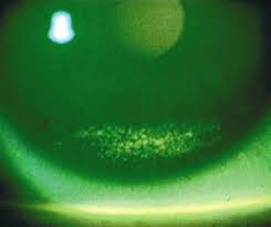
SEAL
Superior epithelial arcuate lesion
Localised
In the superior region of the cornea
Half moon shaped or upside down smile
mechanical irritation and was often cause by SiH
Punctate Staining
Small dot like staining pattern
Generalised staining
can be from various epithelial damage
Which Contact Lens Complications Could Present with a Red Eye?
Which are you most concerned about and why? (6 mark)
Contact Lens Complications That Can Present With Red Eye:
Conjunctivitis
CLARE (contact lens associated acute red eye)
Microbial keratitis
CLPU (Contact Lens Peripheral ULCER)
Chemosis (Allergy)
GPC (Giant Papillary Conjunctivitis)
Acute Dry Eye
Microbial Keratitis is the most concerning as it is vision-threatening and painful.
Your patient presents with pain and their eye looks like this. What can you see and why are you concerned? (3 mark)
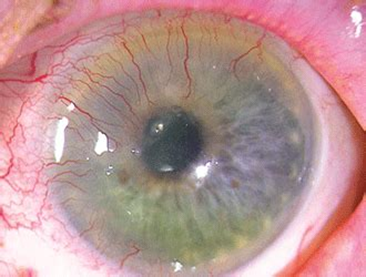
There is neovasculrization present and the cornea is becoming slightly cloudy or opaque. I am concerned as the cornea is likely hypoxic and the new vessels are growing into the central line of vision which could impair sight.
Note: Change px to SiH if wearing hydrogels and reduced wear time if wearing SiH already.
Your patient presents with pain and their eye looks like this. What can you see and why are you concerned? (3 marks)
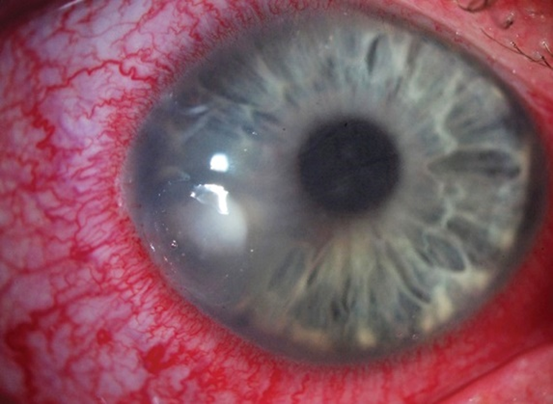
This is Microbial Keratitus and I am concerned because this is a vision-threatening CL complication and needs immediate referal.
Your patient presents with pain and their eye looks like this. What can you see and why are you concerned? (3 marks)

I can see an abrasion on the cornea. I am concerned because this may have been caused by a foreign body or something stuck underneath the eyelid.
BVD Question: Activity 1
Using the Formula, What would the CL prescription be for a patient who has the following prescription?
R +10.50D BVD 12mm
Fc = Fs / (1-dFs)
Fc = +10.50 / (1-0.012 × 10.50)
Fc = +10.25
BVD Question: Activity 2
Estimate the power CL required if a patient had the following prescription.
What power lens would you fit? 3 marks
R -9.00/-1.00 x 180 BVD 12mm
-9.00DS
-1.00DC
BVD 12mm
-9.00 - (-8.00) = -1.00
-9.00 → -8.25D
-8.00 → -7.50
-8.25 - (-7.50) = -0.75
Final Fit = -8.25 / -0.75 × 180
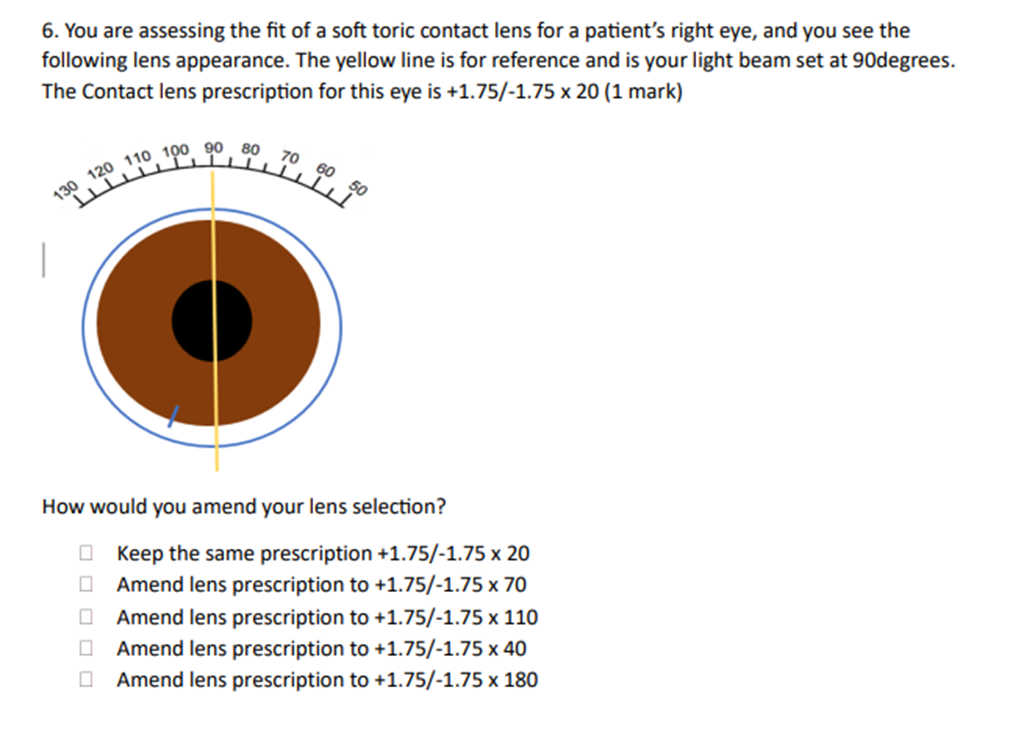
Amend the lens prescription to +1.75 / -1.75 × 40
90-70 = 20
CAAS
so add 20 +20
BVD Activity 4
Using the Formula, what power contact lens would you use for a patient with the spectacle prescription
L +4.75/-0.75 x 172 BVD 10mm
BVS = sphere + cyl/2
BVS = +4.75 + -0.75/2 = +4.25
Fc = Fs / 1-dFs
Fc = +4.25 / 1 - 0.010 × 4.25
Fc = +4.25
List Some Advantages and Disadvantages of Contact Lenses Over Spectacles (6 marks)
Advantages
Contact Lenses have a wider field of view
Can be used in certain occupations where glasses over a certain prescription are not permitted
CLs do not have the possibility of frame allergy
Contact lenses can look more cosmetically appealing
Contact lens can have therapeutic uses
Disadvantages
Contact lenses can become expensive
There is a risk of infection or eye injury
Contact lenses require more maintenance than spectacles
Example Exam Question
Compare and contrast cast moulding and lathe cutting in the manufacture of contact lenses
Cast Moulding
The liquid polymers are pressed between the two moulds and then polymerization occurs.

Lathe Moulding
Then it is polished, rinsed, cleaned and autoclaved
Xerogel is used

Cast Moulding vs Lathe Cutting
Cast moulding requires materials to be pressed between two moulds to create the contact lens
Whereas, with lathing cutting the raw materials are cut, shaved and polished
Cast moulding is the most common and allows for high production of CLs and moulds can be reused
Lathing cutting requires more effort and is not for high production of lenses
Daily Disposables
What do you think are the advantages? 5 marks
Convenient
Does not need storage or cleaning solutions
Less risk for infection
If you damage one you can easily use another
Less contact lens wear and tear
If you fit a patient with extended wear contact lenses, what must you do according to the College of Optometrist’s Guidelines? (6 marks)
You must provide an out of hours emergency number for the patient as well as the local eye casualty department
make them aware that extended wear increases their risk of microbial keratitis
tell them the signs of possible complications to look out for and what to do in these circumstances
ensure they attend for regular contact lens check-ups
Provide them with prescription for the CLs.
Teach them how to clean and care for their contact lenses
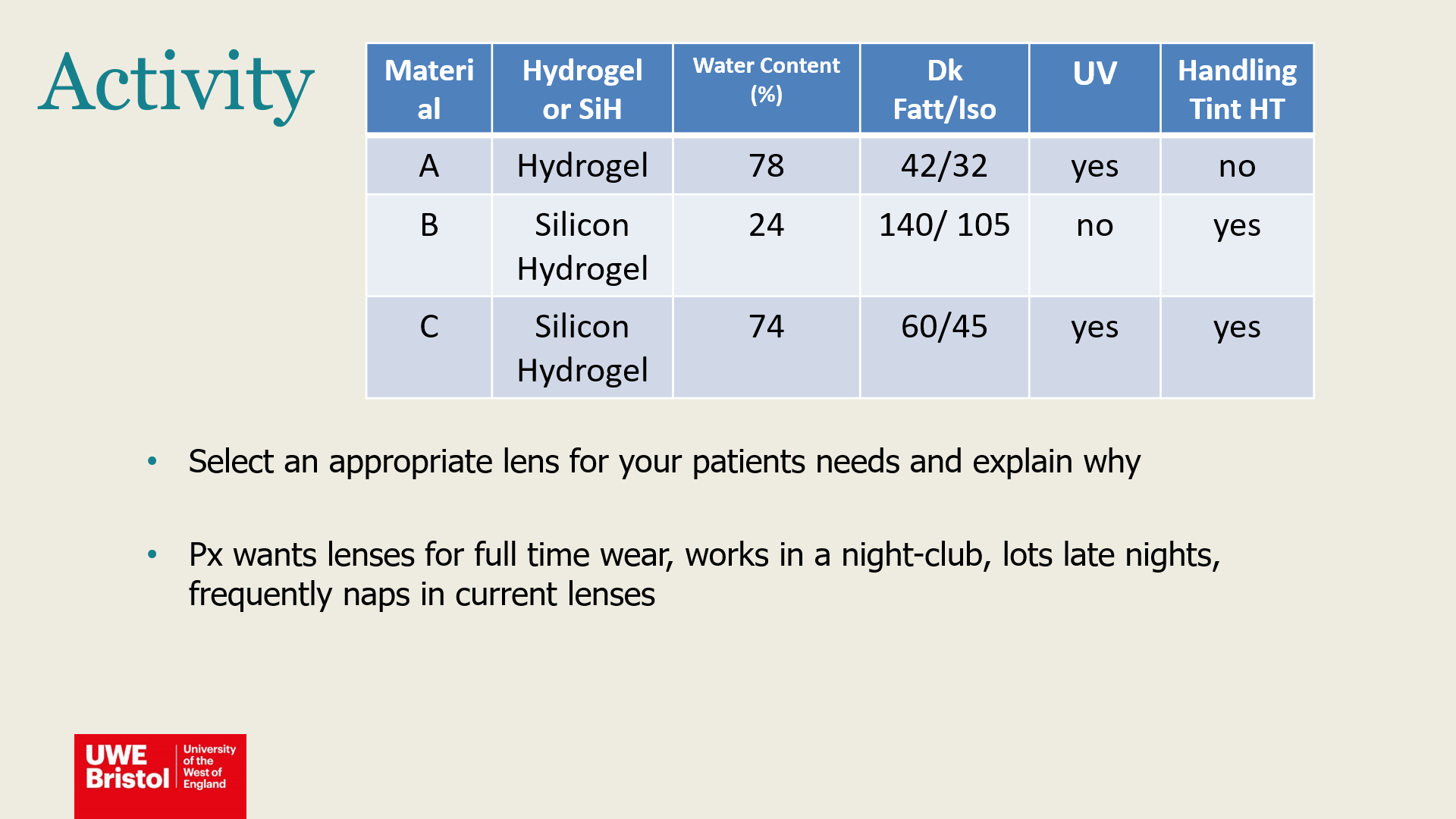
Select an appropriate lens for your patients needs and explain why
Px wants lenses for full time wear, works in a night-club, lots late nights, frequently naps in current lenses
B. Silicon Hydrogel
What is Biofilm and where does it form in a patient who wears contact lenses? (3 marks)
A biofilm is slimy matrix of bacteria.
It forms on the contact lenses and contact lens cases.

Example Exam Question
Why do we advise a patient to avoid water if they are a contact lens wearer? (6 marks)
There is a risk of protozoan keratitis due to acanthamoeba.
Acanthamoeba can threaten vision
Acanthamoeba is often found in home taps and showers
Acanthamoeba is also found in swimming pools
Example Exam Question
Which of the following is the most common cause of microbial keratitis in contact lens wearers?
A. Staphylococcus aureus
B. Fusarium
C. Pseudomonas aeruginosa
D. Streptococcus
E. Acanthamoeba
C. Pseudomonas aeruginosa
Example Exam Question
Which of the following is NOT a risk factor for Acanthamoeba infection?
A. Swimming with lenses in
B. Showering while lenses worn
C. Sleeping with lenses in
D. Wearing silicon hydrogel lenses
E. Reusing daily disposables
D. Wearing Silicon Hydrogel lenses
What are the components of multi-purpose solution? (5 marks)
Purified water
Preservative / disinfectants (e.g. puloquad, polyhexadine)
Tonicity adjusting agents (e.g. sodium chloride)
Buffers (e.g. citrate / phosphate)
Abrasive particles (e.g. EDTA - Ethylenediaminetetraacetic acid)
Viscosity agents and wetting agents (hydroxypropyl methylcellulose)
Example Exam Question:
How would you deal with soft CL monthly patient, using multipurpose solution, who returned and you identified lots of CL deposits? (3 marks)
I would provide my patient with an enzyme cleaner / protein remover (e.g. Papain, pancreatin, Substilisin A or B. This should be used after the daily cleaner and rinsing step and the lenses should soak in the enzyme cleaner.
Which of the following chemicals would be found in a modern multi-purpose contact lens solution?
A. Thiomersal
B. Chlorhexidine
C. Sodium hyperchlorite
D. Pancreatin
E. Polyquad
E. Polyquad
Which of the following chemicals, is the most effective against acanthamoeba?
A. Saline
B. Multi-purpose solution
C. 3% Hydrogen peroxide
D. Surfactant cleaner
E. Enzyme cleaner
C. 3% Hydrogen peroxide
What is your first choice of CL solution that is suitable for most monthly soft disposables and why? (5 marks)
Multipurpose Solution is the first choice. This is because it is an all in one solution and it has cleaning, soaking and wetting covered in its usage. It is convenient and it has low toxicity.
What are the consequences of contact lens deposits? (5 marks)
Reduced vision
Increased risk of infection
Reduced comfort and dryness
Allergic reaction
Reduced lens lifespan
Name 4 contraindications for CL wear. (4 marks)
Active ocular infections or injuries
Lack of motivation for contact lens wear
Dry eyes
Diabetes
Severe allergies
What are the advantages and disadvantages and contraindications of CL wear for this patient?
Age 42year old MALE, might want contact lenses as keeps forgetting his reading glasses, husband suggested it (not convinced himself)
Unaided VA 6/5 L 6/5 n12
Rx R +0.50/-0.75 x 170 VA 6/5 L +0.75/-0.25 x 10 VA 6/5
Add +0.50 n4
GH: Good, type 1 diabetic (25 years)
OH: Hayfever, itchy eyes, left eye scratched due to baby finger nail – irritation lasted 6months
Meds: insulin
Occ: professional diver, swimming coach, readers fog up in swimming pool area
Hobbies: Knitting – difficulty in dim light
Advantages
Wont have to worry about readers
Glasses wont fog up
Disdvantages
Still would need to take lenses out at the pool
May feel like his distance vision is comprimised
Contraindications
Swimming coach
Hayfever
Eye injury
Type 1 Diabetes
Lack of motivation
Small prescription
A teenager’s mother want’s their child to be fitted with contact lenses as they don’t like them in glasses. The child is 15 years old. They also want contact lenses. Which of the following answers is correct regarding consent? 1 mark
You can touch the child’s eyelids and examine them as the parent consented
You should seek consent from both the child and parent
The child cannot give informed consent as they are under 16
The child does not have the capacity to make the decision
You must get written consent from the child and parent before you can proceed.
You should seek consent from both the child and parent
Which of the following can be used to check the fit of a specialist soft contact lens, such as a Hybrid lens used to fit keratoconus?
Sodium fluorescein
High molecular weight fluorescein
Lissamine green
Rose Bengal
Phenol Red
High molecular weight fluroescein
This is because regular fluorescein has a tendency to stain.
Which of the following materials is suitable for overnight wear?
PMMA (Polymethy methacrylate)
HEMA (hydroxyl ethyl methacrylate)
Silicon Hydrogel
Hydrogel
Xerogel
Silicon Hydrogel
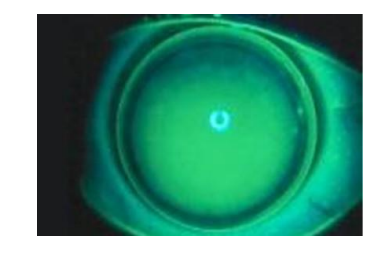
4. How would you describe the fit of this lens? 1mark
Good alignment fit
Steep fitting
Flat fitting
Acceptable but slightly steep
Acceptable but slightly flat
Steep fitting
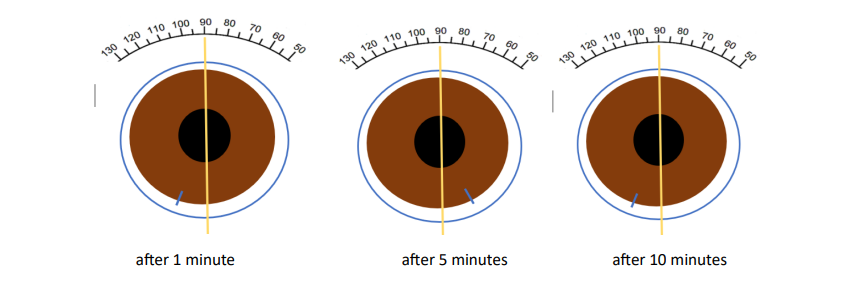
You are assessing the fit of a soft toric contact lens for a patient’s right eye, and you see the following lens appearance. The yellow line is for reference and is your light beam set at 90degrees. The Contact lens prescription for this eye is -1.00/-0.75 x 180 (1 mark)
Keep the same prescription -1.00/-0.75 x 180
Amend lens prescription to -1.00/-0.75 x 20
Amend lens prescription to -1.00/-0.75 x 200
Amend lens prescription to -1.00/-0.75 x 160
Amend lens type to another toric as unstable prescription
Amend the lens prescription to -1.00/-0.75 × 20
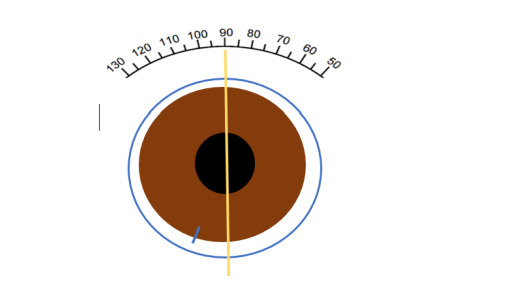
You are assessing the fit of a soft toric contact lens for a patient’s right eye, and you see the following lens appearance. The yellow line is for reference and is your light beam set at 90degrees. The Contact lens prescription for this eye is +1.75/-1.75 x 20 (1 mark)
How would you amend your lens selection?
Keep the same prescription +1.75/-1.75 x 20
Amend lens prescription to +1.75/-1.75 x 70
Amend lens prescription to +1.75/-1.75 x 110
Amend lens prescription to +1.75/-1.75 x 40
Amend lens prescription to +1.75/-1.75 x 180
Amend lens prescription to +1.75/-1.75 x 40
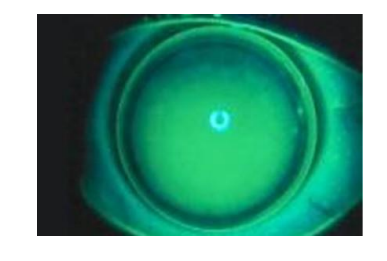
You are attempting to fit your patient with contact lenses. Which of the following is correct regarding this image of a contact lens? 2 marks
This is a soft lens being assessed with fluorescein
This is a Scleral lens being assessed with fluorescein
This is a scleral lens being assessed with blue light
This is an RGP being assessed with a green light
This is an RGP being assessed with lissamine green
This is a scleral lens being assessed with blue light
This is an RGP being assessed with fluorescein
This is a soft lens being assessed with lissamine green
This is an RGP being assessed with fluorescein

If you are assessing the fit of a soft contact lens for a patient’s left eye, and you see the following lens behaviour, which of the following is the most accurate record keeping? 2 marks
Decentred inferiorly, 100% nasal lag
Decentred inferiorly, 100% temporal lag
Decentred nasally, 100% temporal lag
Decentred nasally, 100% nasal lag
Decentred superior, 100% downgaze lag
Decentred superior, 100% upgaze lag
Decentred temporally, 100% nasal lag
Well centred, no lag
Well centred, no lag
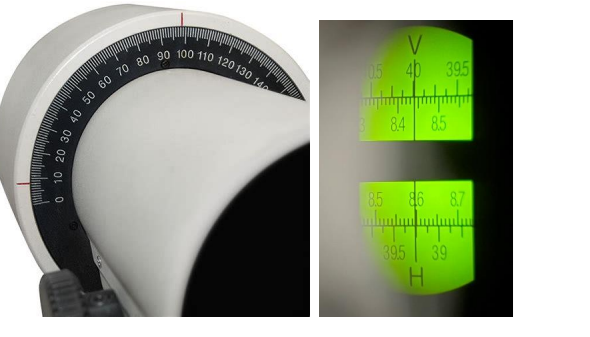
If you saw the following keratometry mires, how would you record the results? 1 mark
8.4@8 and 8.6@100
8.4 x 100 and 8.6 x 10
8.44@98 and 8.6@8
8.44@8 and 8.6@108
40@100 and 86@8
40@98 and 39.75@10
8.6@H and 8.44@V
8.44@98 and 8.6@8
When considering the classification of dry eye disease, which of the following is not a subcategory?
Evaporative
Aqueous deficiency
Osmolaritive
Both evaporative and aqueous
Both evaporative and osmolaritive
Osmolaritive
Why might using a topographer/tomographer be preferrable over a keratometer? (5 marks)
Better for custom lens design
Allows posterior corneal data
Quantitative and qualitative analysis
Detection of corneal irregularities (e.g. keratoconus)
More comprehensive corneal mapping as it does the entire anterior surface whereas the keratometer only does the central 3mm of the cornea
Using the conversion formula, show your workings for how you would calculate the power for a soft toric contact lens trial for the following spectacle prescription 4 marks
(If you are unable to remember the formula, and can estimate the CL trial power using another method there is 1 mark available for that answer) R +14.00/-4.00 x 180 BVD 12mm
R +14.00/-4.00 x 180 BVD 12mm
+14.00 - x = -4.00
x = +18.00
Fc = Fs / 1-dFs
Fc = +14.00 / 1-0.0012 x +14.00
fc = +16.82 → +16.75
Fc = Fs / 1-dFs
Fc = +18.00 / 1-0.0012 x +18.00
Fc = +22.96 → +23.00
+18.00-23.00 = -5.00
+16.00 / -5.00 × 180 ??? (Redo if I have time)
Describe the material properties and wearing schedules that would mean developing corneal neovascularisation would be more likely? 4 marks
The contact lens would be hydrogel not silicone hydrogel
The water content of the hydrogel would be high
The contact lens would be thick
The contact lens would be overwon
The contact lens would most likely have been slept in
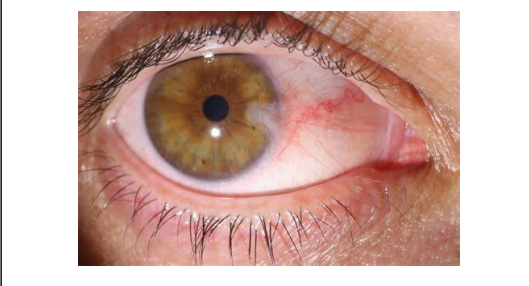
What condition is shown and will this impact their ability to wear contact lenses? 2 marks
Would you recommend any specific contact lens or contact lens feature to this person and why? 2 marks
The condition shown is a pterygium and it will affect their contact lens wear until it resolves.
I would recommend that that have a contact lens that has UV protection as pterygiums are often due to overexposure to UV rays.
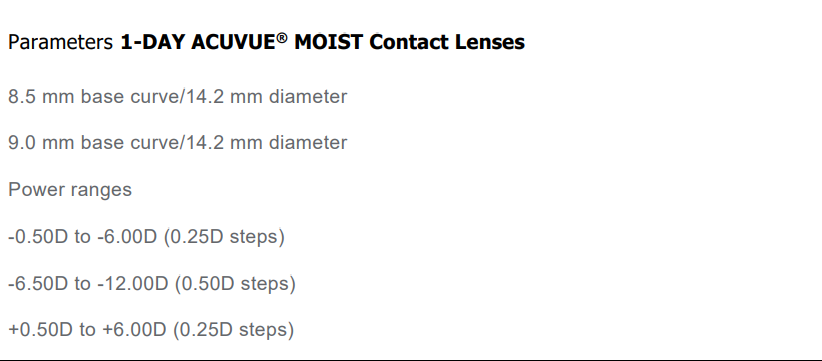
If you were fitting a patient with a soft lens and their measurements were HVID 12mm, Pupils 4mm in bright light and 6mm in dim light, and K’s of 8.3@90 and 8.4@90 R -3.75/-0.50 x 180 (3marks)
They would need a spherical lens.